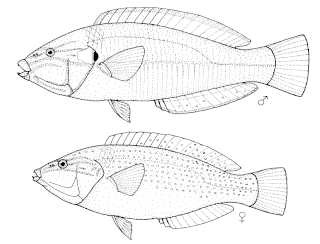
Notolabrus fucicola, the banded parrotfish, blue wrasse, kelpie, New Zealand banded wrasse, purple parrotfish, saddled wrasse, Southern purple wrasse, Southern wrasse, winter bream or yellow-saddled wrasse, is a species of wrasse native to the eastern Indian Ocean, off eastern Australia and all around New Zealand on rocky, weedy reef areas. Aging work in New Zealand suggested these wrasses can live at least 35 years.

The Odacidae are a small family of ray-finned fishes commonly known as cales and weed whitings, formerly classified within the order Perciformes. They are related to the much larger families of the wrasses and parrotfish. More recent workers have classified this family within the order Labriformes, alongside the wrasses and parrotfishes, within the clade Percomorpha.

Anampses is a genus of wrasses native to the Indian and Pacific Oceans.

Choerodon is a genus of wrasses native to the Indian Ocean and the western Pacific Ocean. They are commonly referred to as tuskfish, because most species have sharp tusk-like teeth.

Notolabrus is a genus of wrasses native to the eastern Indian Ocean and the southwestern Pacific Ocean from Australia to New Zealand.

Pseudolabrus is a genus of wrasses native to the eastern Indian Ocean and the Pacific Ocean.

Thalassoma is a genus of wrasses native to the Atlantic, Indian and Pacific Oceans. Many species occasionally make their way into the aquarium trade.

Pseudocheilinus is a genus of wrasses native to the Indian and Pacific Oceans.

The inscribed wrasse is a species of marine ray-finned fish from the family Labridae, the wrasses. It is found in the southwestern Pacific Ocean.

Labrus is a genus of wrasses native to the eastern Atlantic Ocean into the Mediterranean and Black seas.

Labroides is a genus of wrasses native to the Indian and Pacific Oceans. This genus is collectively known as cleaner wrasses, and its species are cleaner fish.

Prionurus laticlavius the razor surgeonfish or razor sawtail, is a species of marine ray-finned fish belonging to the family Acanthuridae, the surgeonfishes, unicornfishes and tangs. This fish is found in the eastern central Pacific Ocean.

Parablennius is a diverse genus of combtooth blennies found in the Atlantic, western Pacific, and Indian Ocean.

Cymolutes is a genus of wrasses native to the Indian and Pacific Oceans.

Gomphosus is a small genus of wrasses native to the Indian and Pacific Oceans.

Iniistius is a genus of wrasses native to the Indian and Pacific Oceans.

Oxycheilinus is a genus of fish in the family Labridae found in the Indian and Pacific Ocean.

Pteragogus is a genus of wrasses native to the Indian Ocean and the western Pacific Ocean.

Pictilabrus laticlavius, the patrician wrasse, the senator wrasse, the green parrotfish or the purplebanded wrasse is a species of marine ray-finned fish from the family Labridae, the wrasses. It is found in the eastern Indian Ocean and the south western Pacific Oceans off he temperate coasts of southern Australia.

Pseudolabrus eoethinus, the red naped wrasse, is a species of marine ray-finned fish from the wrasse family, Labridae. It is found in the northwestern Pacific off the coast of Japan, Taiwan and in the South China Sea. This small species of wrasse, with a standard length of up to 207 millimetres (8.1 in), which is common on rocky reefs, in waters no deeper than 30 metres (98 ft). This species lives in small harems made up of a single territorial male and a number of females. Spawning takes place from mid-November to mid-December with the fish pairing up and spawning within the male's territory. P. eoethinus associates with the Spottedtail morwong, feeding mainly on crustaceans and molluscs. This species was first formally described as Labrus eoethinus by the Scottish naturalist and naval surgeon John Richardson (1787-1865) in 1846 with the type locality given as Canton, China. Previously, Coenraad Jacob Temminck & Hermann Schlegel applied the name Labrus rubiginosus to specimens they examined but this name was invalid although Pieter Bleeker used this name for the Type species of his new genus, Pseudolabrus in 1862.




















